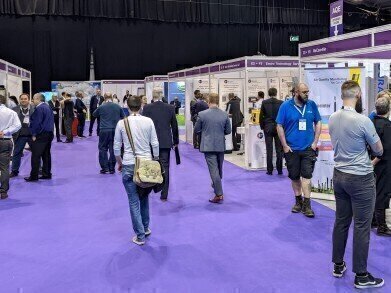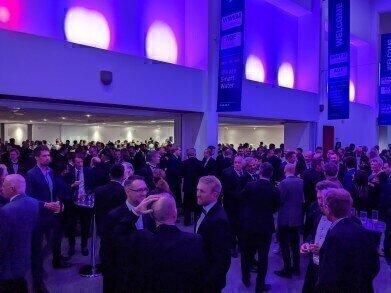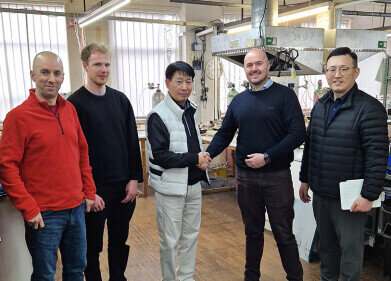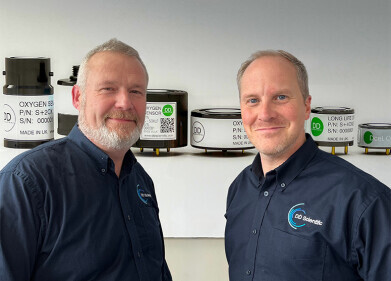Business News
WWEM and AQE Reflect Growing Importance of Environmental Monitoring
Nov 10 2022
There was an extra buzz at this year’s WWEM and AQE events; not just because the speakers, exhibitors and visitors were excited to finally meet each other face-to-face again, but also because of numerous exciting developments in the environmental monitoring sector. For example, the Environment Act 2021 states that a sewerage undertaker must monitor upstream and downstream of an asset where water quality is potentially affected by discharges from storm overflows. There are thousands of these in the UK.
Similar large-scale projects exist in the air quality sector. For example, AQE speakers from Vodafone described a preliminary study on the suitability of their base station masts to host air quality sensors for outdoor pollution monitoring. Vodafone has thousands of these masts in the UK.
In combination, WWEM (Water, Wastewater & Environmental Monitoring) and AQE (Air Quality & Emissions) offer everyone involved with environmental protection an opportunity to learn about the latest regulations, standards, methods, processes and technologies. With up to ten different presentations running simultaneously across the two events, visitors were provided with a wide variety of technical and application-specific content to choose from.
Monitoring for the Environment Act of 2021
Many of the presentations across both AQE and WWEM addressed the implications of the Environment Act 2021, which was established, post-Brexit, to create new rules on nature protection, water quality, clean air and other environmental issues that were previously addressed by EU directives.
The Environment Act provides the UK Government with powers to set new binding targets, including for air quality, water, biodiversity, and waste reduction. It also establishes a new environmental watchdog, the Office for Environmental Protection (OEP), which will hold the Government and other public bodies to account, and ensure compliance with environmental laws.
When the Environment Act became law, the (then) Environment Secretary, George Eustice said: “These proposed targets are intended to set a clear, long-term plan for nature’s recovery. In a post- EU era, we now have the freedom to move towards a system that focuses on nature’s recovery as well as its preservation, and which places more emphasis on science and less emphasis on legal process. This change in approach will help us in the pursuit of the targets we are setting under the Environment Act.”
The Environment Act’s focus on targets is good news for everyone involved with WWEM and AQE, because environmental initiatives need to be underpinned by data, and regulated processes need to know the limits that apply to them, so that they can check compliance and plan any necessary investments to ensure ongoing compliance.
Under the new Act, targets on water quality will tackle the most significant pressures on the water environment and help unlock the most serious challenges to clean up England’s rivers, as well as support wider ambitions in the 25 Year Environment Plan for clean and plentiful water. For air quality, the Act will create at least two new legally binding targets for one of the most harmful pollutants, fine particulate matter (PM2.5), for which the government proposed a new legally binding target to reduce levels of PM2.5 to 10 µg/m3 by 2040.
The proposed targets were subject to an eight-week consultation period in which the government sought the views of environment groups, local authorities and other stakeholders. Unfortunately, this consultation expired on 31st October 2022, and the government webpage now says: “We received over 180,000 responses to the consultation, which all needed to be analysed and carefully considered. Due to the volume of material and the significant public response, we have not been able to publish targets by 31 October 2022, as required by the Act. We continue to work at pace to lay draft statutory instruments as soon as practicable. We expect to publish the summary of responses and government response when we finalise the suite of Environment Act 2021 targets.”
Such a failure, at the first hurdle, to meet the requirements of the Act has inspired widespread frustration, with a major alliance of green groups submitting a letter of complaint to Defra.
New Infrastructure, Indoor Air and Amines-Based Capture: AQE 2022
The programme for AQE was drawn-up by Jim Mills, an independent consultant with Scotswolds Ltd., in collaboration with Vodafone, Vantage Towers and Cornerstone. Speakers addressed current air quality issues from a number of different perspectives, including regulation, research, philanthropy, and measurement technology. Fine particulates featured in almost all presentations, but there were also common themes such as the impacts of electric vehicles, non-exhaust emissions, wood burners and the combustion products of alternative fuels.
A potentially game-changing project was described in which work is being undertaken to investigate the suitability of telecommunications infrastructure to host air quality monitors. Jim Mills has been advising Vodafone on its investigations and has helped to establish an evaluation of existing air quality monitoring technologies (11 monitors from 6 manufacturers). There is the potential to install them at up to 14,500 locations on the Cornerstone mobile infrastructure estate, of whom Vodafone is an existing tenant and also across Europe on the Vantage Towers infrastructure.
In the past, there have been concerns that monitoring and modelling have been regarded as almost separate methods for the assessment of air pollution, so speakers outlined the case for greater integration. Similarly, the relationship between air quality, climate change and net zero was addressed because; while most climate mitigation measures help air quality, not all do.
Various presentations also addressed the role of air quality monitoring networks, low-cost sensors, and citizen science, as well as the utilisation of air quality data in traffic management, for example.
AQE visitors were reminded that people spend a greater proportion of their time indoors than some whales spend under water, so whilst ambient air quality is important, indoor air quality is more so, and the role of ventilation and building management was discussed widely.
A full programme of presentations also addressed the latest issues in monitoring emissions to air. This included, for example, the measurement of biogenic carbon dioxide. The combustion of fuels with mixed fossil and biogenic components means that monitoring must discriminate between the two different sources of CO2, and speakers explained how this can be achieved.
Carbon capture is once again highly topical; however, amine solvents are used in some carbon capture processes, which can react to form new compounds within the plant’s emissions. Speakers therefore described current research projects and the requirements for monitoring amine emissions.
The second day of the AQE emissions monitoring programme also focused on data acquisition, handling and reporting, with reference to EN 17255, the standard for DAHS with regard to stationary source emissions. This standard is comprised of four parts, and there were separate presentations on each part.
Outflows, Overflows, and Data-Driven Solutions: WWEM 2022
A comprehensive programme of presentations was developed for WWEM 2022 by Oliver Grievson, who received an Outstanding Contribution Award at the event’s Gala Dinner. The presentations covered almost every conceivable aspect of water, wastewater and process water monitoring. It was presentations on river water quality and storm overflows, in particular, that attracted the largest crowds, often leaving standing room only.
Phillip Dunne MP, Chair of the Environment Audit Committee (EAC), delivered a keynote presentation, reporting the results of the EAC’s investigation into river water quality. He expressed his pride for the resulting amendment to the Environment Act that will force water companies to install continuous monitors at every outflow from every asset. He highlighted the importance of continuous monitoring, because it enables water companies to take fast action, and he encouraged them to change their priorities and invest more heavily in solutions.
Dr Philip Hulme, who leads the Environment Agency’s management of storm overflows and drainage wastewater, then explained that there are around 15,000 storm overflows in England in Wales and that in 2021, they overflowed on average about 29 times and did so for an average of over 7 hours. This information is based on data from event duration monitors (EDMs). He said that action is obviously necessary, but that this would have an effect on water bills.
Alastair Chisolm from CIWEM reminded the audience that storm overflows are not just an issue for water companies. A multi-faceted approach is needed to improve drainage and manage increased volumes of sewage, highway runoff, higher levels of impermeable surfaces, and climate change.
Other speakers returned to the issue of monitoring and discussed the challenges of monitoring coastal waters, as well as the calibration requirements for ammonium monitors, and the management of the large amount of data that will be generated by the increased number of continuous water quality monitors. Calibration frequency was addressed by Matt Dibbs from Meteor Communications, which already has around 700 continuous water quality monitors installed on UK rivers. He said that with sufficient investment in calibration facilities and field staff, it is possible to swap calibrated sondes on a scheduled basis to deliver reliable data for all key parameters, including ammonium.
Looking forward, further work will be necessary to optimise the value of insights from the large amounts of data that will be generated. However, Matt said the fundamental benefit of upstream and downstream monitors will be to instantaneously determine the relative impact of discharges.
WWEM’s Flow Forum featured speakers from the Environment Agency, Thames Water, Morrison Water Services and the Coal Authority, with presentations covering the latest requirements and practical insights for installers and operators of flow monitoring equipment.
Elsewhere, speakers covered the digital transformation of the water sector through better information management in the control of water and wastewater assets and services. Also, a series of SWAN (Smart Water Networks Forum) workshops brought together key players to collaborate and accelerate the use of data-driven solutions in water and wastewater networks. As a vital component of digital transformation, developments in communications technology are the enablers of the advantages that are now being realised, and speakers described the latest advances in a range of communications technologies.
The hugely popular Instrumentation Apprentice Competition was again run throughout the first day of WWEM 2022. During the Gala Dinner, Alex Ward and Dan Alty of United Utilities were announced as winners, with prizes presented by Kriss Akabusi, Andy Godley and Oliver Grievson.
What’s Next for AQE and WWEM?
Summarising AQE and WWEM 2022, event organiser Marcus Pattison said: “It was an enormous relief to be able to return to normal ‘physical’ presentations and exhibitions, and the excitement at being able to do so was palpable. Clearly, the importance of environmental monitoring has grown in recent times, so WWEM and AQE provided an ideal opportunity for visitors to learn about the ways in which monitoring can be accurate, reliable, cost-effective and insightful.
“Looking forward, we are delighted to announce that the next WWEM and AQE events will take place on the 9th and 10th October 2022 - at the NEC!
“That’s right: we are moving! We are extremely excited to be re-locating to the NEC, which not only offers us greater room but with better air and rail transport infrastructure, we hope that this location will be more convenient for our visitors.
“We are delighted to report a dramatic vote of support from our exhibitors, too. We are now able to offer more flexibility on stand sizes – more than half of the stands have already been sold! So, preparations are underway, and we look forward to welcoming everyone to the NEC in 2024.”
Digital Edition
IET 34.2 March 2024
April 2024
Gas Detection - Biogas batch fermentation system for laboratory use with automatic gas analysis in real time Water/Wastewater - Upcycling sensors for sustainable nature management - Prist...
View all digital editions
Events
Apr 30 2024 Melbourne, Australia
Apr 30 2024 Birmingham, UK
May 03 2024 Seoul, South Korea
May 05 2024 Seville, Spain
May 06 2024 Minneapolis, MN, USA






















